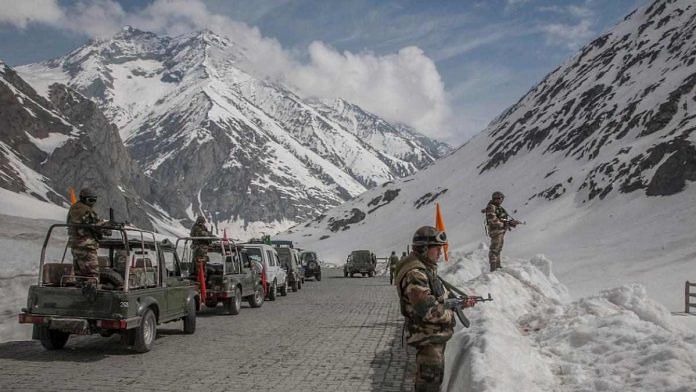New Delhi: The eighth round of military talks between India and China will focus on finalising the exact locations of the buffer zones to be created along the Line of Actual Control (LAC) in eastern Ladakh with an aim to work out a partial disengagement of troops over the next three weeks before the heavy winter sets in, ThePrint has learnt.
After the 15 June Galwan Valley clash, which led to the death of 20 Indian soldiers and an unconfirmed number of Chinese soldiers, the two armies had chalked out some buffer zones at the local level. These zones will now be formalised at the higher levels, government sources said.
Buffer zones would be areas on both sides of the LAC where neither army conducts patrols.
The eighth round of talks, the latest in a series of dialogues meant to ease months-long tensions at the LAC, are likely to be held this week. They assume significance as any large-scale redeployment of troops or de-induction will need to be carried out before the passes close by the last week of October.
At the seventh round of talks, both sides agreed on early disengagement. According to sources, based on the discussions held during the seventh rounds of talks, a series of proposals and counter-proposals were exchanged between both sides.
The proposals included earmarking all friction points as demilitarised areas with mutually agreeable buffer zones created between the two armies, and delineating the limit of patrolling accordingly to prevent any escalation.
The major friction points along the LAC include the Finger 4 area of the Pangong Tso, certain key features on the southern bank of the lake, the Y-junction at Depsang Plains, and the Galwan Valley and Hot Springs areas. Indian troops are currently not patrolling most of these areas.
“There would be discussions on these points between the military commanders, so as to decide on the exact locations on ground. If the talks go well, this would be translated on ground within two to three weeks,” a source told ThePrint.
The two sides have also discussed pulling some of the armoured and artillery units back by a suitable distance.
“However, considering the nature of terrain and the time taken to redeploy troops on the Indian side, India would not completely de-induct them and they would continue to remain at suitable places along the DS-DBO road in the northern sector and Chang La in the southern sector,” a source said.
The Chinese, meanwhile, could move their armoured and artillery units away to their permanent locations, since the flatter terrain on their side — as well as the infrastructure available to the People’s Liberation Army (PLA) — allows them to redeploy in a shorter timespan, sources said.
Also Read: Why has India’s China policy been such a failure? Question New Delhi’s assumptions first
De-induction of infantry
A second source said the de-induction of infantry from their current locations at the LAC can only take place once each side decides they are willing to cede to the proposal, and a decision is taken on the exact extent.
“Once these buffer zones have been earmarked on ground, a certain amount of thinning of infantry may take place as a confidence-building measure. The level of withdrawal will depend on faith being reposed in each other during the talks,” the source said.
Depending on how the next round of talks progress, the pull-back of the additional reserve troops can happen, in two parts, sources said.
“They would be pulled back either near ‘suitable locations’ within Ladakh, while some may even be inducted back to their permanent locations,” a source said.
Any breakthrough in the talks between India and China has been precluded by the latter’s insistence that India move out of the southern bank of Pangong Tso. India has made it clear that disengagement has to be at all friction points.
Also Read: Govt looking at ‘highly confidential’ China proposal to reduce tensions in Ladakh







If india do 1000000000000 meetings with china, i sure india will never get any rezult.
Meetings pe meeetings
It looks cold is more severe at Indian side than Chinese !!! Godi media made us believe that Chinese soldiers were weeping on border not capable of confronting high altitude warfare traind Indian army but developments suggest vice versa !!! Fenku & his team is serving us with blatant lies be it Laddakh, Pulwama, Balakot or Pathankot !!!
The basic problem is boarders are not clearly marked. Even in 1914 Simla treaty was boycotted by China. China never accepted mcmohan line. The entire length of around 4000 KM’s became a buffer zone. To resolve this issue some historical knowledge combined with systems ship is required.
Infact alliance of india with america is not more than a trap.
America will bring india in war with china and then itself stands off and see the drama “what happens “. America never loyal to anyone, it always see their own interest that how to sell their arms to india.
This is what I feared most. As usual, the BABUS in the MEA have cheated this govt. too. It is against our national interest to repeat what they did in 1971 after the creation of Bangla Desh. We were persuaded to release 93,000 Pakistani POWs without solving the KASHMIR ISSUE. Likewise, without reestablishing our right to go back to the areas where we were patrolling before the present incursion by China, we are once again asked to establish buffer zones that would prevent us permanently to lay any claim to those areas in future & concede them permanently to the Chinese. Once again the BABUS in the MEA have defeated well – meaning strategic advice by defence experts like Gen . Bakshi , Marroof , & Challany. Poor Mody , his govt . of cowardice & we ,the ever -believing divided society.